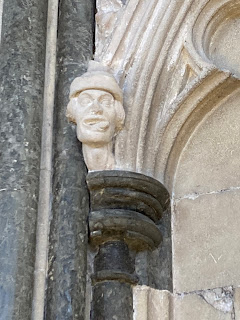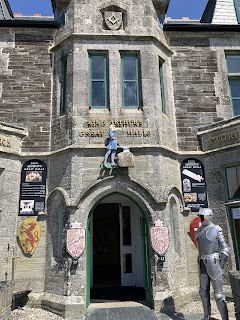London: Part One
The Spain choir tour had come to an end. Most everyone was heading back to Canada. We opted to add a trip to England as we'd always wanted to go there but just hadn't made it happen.
We were up at 4:30 to catch the shuttle to the airport and before long, were landing at Heathrow. After having been in a land where you were struggling to communicate with their broken English and our minimal Spanish, it was strange to be addressed fluently in English. Should I reply in another language? Ah, it's a foreign country where they DO speak my language!
We got on our way to London, taking the Heathrow Express to Paddington Station and then the Tube to Victoria Station. Like a little gopher we resurfaced, very lost. Some kind soul pointed us in the right direction and we made our way to our hotel.
 |
| good thing there was a lift! |
We were exhausted, but this is London and it was a beautiful day. Those might not happen every day so we had to go explore, at least for a little while.
 |
| Buckingham Palace |
 |
ice cream break on The Mall
|
 |
| This is The Mall where the crowds gather for royal events. |
 |
The Shakespeare
one of many British pubs and our stop for supper.
Fish and Chips of course! |
RABBIES TOUR:
Day 1:
Like the typical tourists we saw around us, we too were walking down the street, dragging our suitcases behind us. We were on our way to join a tour of Southwest England.
We went with Rabbie's Tour company. Jennifer was our trusty driver, negotiating the narrow roads and streets without difficulty. And driving on the other side of the road! Glad it was her driving, not us!
We were fifteen passengers from Canada, US and Australia.
Winchester:
The first stop was Winchester, an ancient capital of England going back to before Roman times.
It doesn't take long before one realizes there are so many layers of history in this city, from Iron Age to Vikings to Romans; Anglo-Saxons to Alfred the Great to William the Conqueror and more. It takes a while to get some of the times and dates sorted. Or one just doesn't worry too much about the historical eras and enjoys the views and the beautiful architecture and ruins.
 |
| a bakery cafe for lunch |
 |
| Gateway from the city walls, built in the 12th century |
Stonehenge:
We continued driving and then as we went over a rise, there it was - Stonehenge. The rocks were much larger than I'd expected them to be. It was quite impressive. Research shows that the stones were arranged in this place anywhere from 3000 to 2500 BC. There is a great deal of reading one could do about it. We wandered around, enjoyed taking fun photos, and speculated on the history of the place.
Exeter:
After another hour or so on the road, we arrived at our accommodation for the next two nights in the city of Exeter. We stayed in Townhouse B & B, a lovely 150 year-old house. In the morning, breakfast was delivered to the rooms as per the menu requested the night before.
Exeter has a long history, dating back to Roman times. It was known for its woolen industry, but now it's a university city. The beautiful cathedral was built in the 1400s. We were able to attend choral Evensong the one night. This was exactly what I'd been looking forward to in England - to hear youthful voices singing in the expanse of a great cathedral.
When you stop for photos and get off the bus to explore, a short 50 minute drive between two towns can take all day. The weather was perfect and our driver was willing to stop for many photo ops.
Dartmoor National Park is a vast desolate place covered in scrubby bush with tors (rock outcrops) on the hilltops. The Dartmoor ponies run free, while sheep and belted Galloway cows are kept behind the stone fences near the few villages that dot the moor. It felt so remote, yet wasn't really that far away from the rest of the country.
 |
evidence of civilizations from the Bronze age
with an avenue of white quartz stones
perhaps placed for ceremonial purposes |
 |
| the 'modern' bridge next to the Clapper Bridge |
 |
an ancient Clapper Bridge, three giant slabs of granite,
probably built in the 13th century
 | Tavistock, a market town where we stopped for lunch and exploring.
Dave and I found "The Original Pasty House" for our first taste of Cornish Pasties. |
|
From there it was back to Exeter for the late afternoon, dinner at an Italian restaurant, and night.
Day 3:After another breakfast basket delivered to our room (croissants, fruit & yogurt and French-press coffee) we were on our way to explore the coast of Cornwall. After all, Cornwall is surrounded by the sea on three sides.
For the next two days we popped in and out of coastal villages and stopped to see the vistas of coastal cliffs and ocean. If one was real ambitious, there is a South West Coast Path that one can take along the shoreline. It's over 1000 km, and was once used by the coastguard patrolling for smugglers. But we didn't fancy that long of a walk. We'll ride in the coach.
Boscastle is a little fishing village hidden in a rugged valley right close to the ocean. It hit the news with a devastating flood in 2004. Thankfully there was no loss of life.
 |
| imagine this little stream becoming a raging torrent of water |
 |
| first glimpses of the ocean at low tide |
Tintagel is the place associated with the stories of King Arthur. We were given the option of crossing the foot bridge and clambering over the island looking at the ruins of the Arthurian castle, or walking along the streets and enjoying a leisurely lunch. We took the latter, and added a visit to the Great Hall telling the legend of King Arthur.
 |
The best Cornish Pasty - a hand-held meal for miners.
The original Pizza-Pop? |
 |
| another knight for the Round Table |
 |
| King Arthur, man or myth? |
Port Isaac is another beautiful fishing village. It became famous most recently as Port Wenn, the setting of the Doc Martin series. We'd watched the whole series and I'd always wanted to see it in person. Now here we were. It was even prettier than I'd imagined, and we had the most beautiful weather to walk around and see all the places the characters had been. I'd almost expected to bump into Doc Martin, Louisa or Bert at the Golden Lion.
The real story, though, was about the gulls. We'd bought ice cream cones and as we wandered onto the beach a gull swooped over my shoulder and nearly knocked my cone out of my hands. Before I could process what had just happened, it took another round from the other side. I had to hide the cone and eat it fast! The next day, I came across this tea-towel in the gift shop in St. Ives. I had to buy it.
To get to Falmouth from the other side of Cornwall was a slow drive along the many narrow roads with hedge-rows and no ditches. Jennifer did her magic and got us there safely.
Falmouth was our home for the next two nights. It's a port city with a very wide natural harbour at the mouth of the Fal River. Our hotel, The Poltair, was about a half-hour walk to the downtown restaurants and shops, although we didn't arrive in time for much shopping. It was beautiful to eat our dinners, overlooking the harbour.
 |
Delicious pizza at The Stable.
We must have been hungry as we ate the whole thing! |
 |
| the best fish n chips ever at Harbour Lights |
Day 4
The next morning we enjoyed a full English breakfast before beginning another coastal drive. We've been blessed with sunny weather every day.
St. Michael's Mount is the English counterpart to a similar place in France. We stopped briefly for some photo ops. It's a tidal island and wasn't accessible on foot as the tide was in, but one could go there by boat. The castle was built some time in the 1600s.
We had to hurry on to Minack Theatre. What a beautiful surprise. It's a theatre built into the side of the cliff with grass seating, lovely plants along the walk-ways and when watching a show, the distracting view of the sea. We had a chance to hear an actor tell a little bit about the vision and construction of the place. Too bad we couldn't come by for a full evening's show.
Although Jennifer, our driver and guide, felt that Land's End was really just a tourist trap, (I would concur) it was also a fun place to stop for a photo op. This is the westernmost point of England. Next stop Canada. We've been to the easternmost point of Canada. It's a bit of a Buster Keaton moment. (If you know, you know.)
The Botallack Tin mine ruins are one of the many remains of tin and copper mining in Cornwall. They have been closed for over a century. This place is beautiful and quiet now, not the bustling noisy mine work with shafts chiseled half a mile under the seabed.
Then it was off to St. Ives. It's as pretty as the name sounds, a seaside place to come and play. We could have stayed all day - if we'd remembered to bring flip-flops and beach wear. Oh well. We found some wonderful shops and a very pink tearoom for scones and clotted cream (for me) and The Art of Brewing (for Dave).
We returned to Falmouth for the evening with a bit of time left to find the beach and find dinner.
The next morning it was onto the motor way to put on the miles back to London. Dave and I left the tour in Glastonbury to visit with friends for the weekend.
As far as the Rabbie's Tour went, it was so wonderful. It was better than expected with so many stops along the way. The downside, though, was that it was more of a highlights tour as we had time limits on each stop. We probably could have stayed all day at any one of the places. But if you've come all this way, you want to see it all and we certainly did.
































































































































